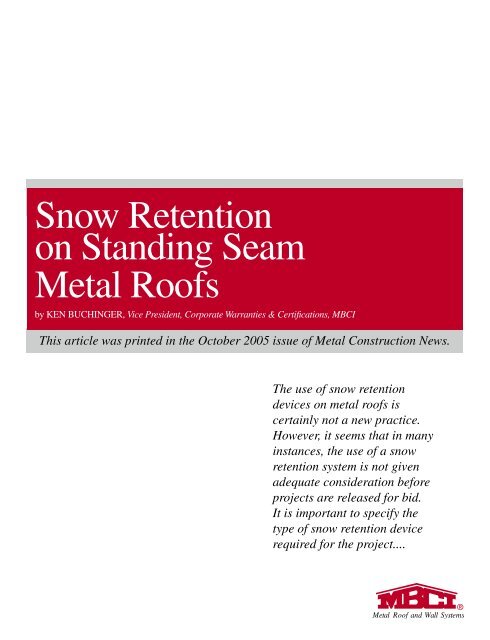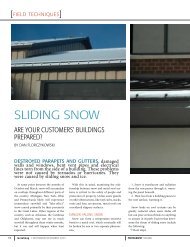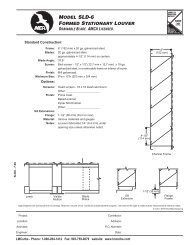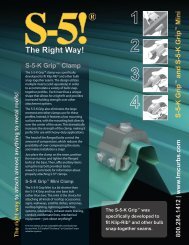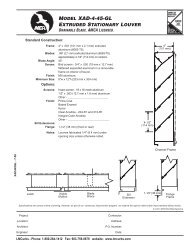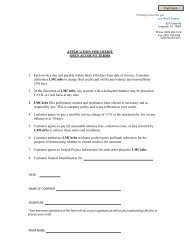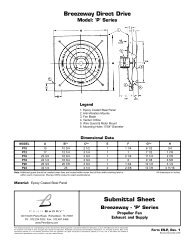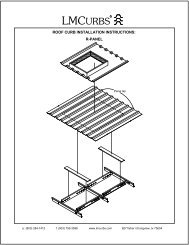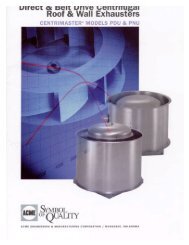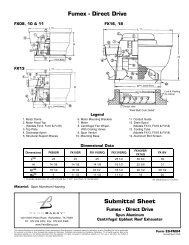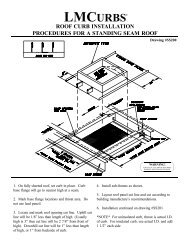Snow Retention On Standing Seam Metal Roofs - MBCI
Snow Retention On Standing Seam Metal Roofs - MBCI
Snow Retention On Standing Seam Metal Roofs - MBCI
Create successful ePaper yourself
Turn your PDF publications into a flip-book with our unique Google optimized e-Paper software.
Many different systems are used. Some are effective, whilemany are not. For instance, never use a snow retention devicethat is attached with screws. This not only perforates the roofpanels but it can also pin the roof and prevent it from floatingas designed. <strong>Snow</strong> retention systems which utilize clamps thatattach to the standing seams of the roof panels are typicallythe best choice. These clamps have been tested and can beengineered for the specific roof to which they will be attached,allowing for the snow load, roof slope, panel run length andother roof details. These clamps do not penetrate the roofmembrane, do not hinder roof expansion and are easily installedwith a screw gun.• If a gutter is used that has a face higher than the pan of theroof panels, the gutter must be protected from sliding ice andsnow. Gutter is designed for one purpose – to channel the waterto a downspout. It does not serve a secondary function as a snowretention device. Designers often assume that this “Southernstyle” gutter will hold ice and snow on the roof.Gutter left unprotected cannot resist sliding ice and snow.S-5! ColorGuard snow retention system installed at the building eaveutilizes clamps that attach to the panel seam without penetrating it.• Pipe penetrations should also be protected from sliding ice andsnow. As ice and snow slides down a roof and encounters a pipepenetration, the force can cause the pipe to move down slope anddamage both the roof jack and the roof, or shear the pipe at theroof surface. This can happen with PVC or cast iron pipe.It is also critical to determine the areas on the roof which requireprotection from sliding ice and snow. Oftentimes, the only areasthat are considered for snow retention are building entrancesor areas of pedestrian traffic, such as sidewalks, adjacent to abuilding sidewall. While these are indeed the most critical areas,other areas that require protection, often overlooked, include thefollowing.These pipes were left unprotected and have suffered damage due tosliding ice and snow.Typically, only a short section of the snow retention system isneeded to protect pipe penetrations. It is much less expensive toprovide protection for penetrations such as vent and flue pipesthan to replace them when sliding ice and snow shear them off ofthe roof.This picture shows how sliding snow reacts when encounteringan obstacle such as a pipe penetration or gutter.
<strong>Snow</strong> <strong>Retention</strong>on <strong>Standing</strong> <strong>Seam</strong><strong>Metal</strong> <strong>Roofs</strong>Ice and snow sliding down the main roof has damaged the roofpanels and the valley trim on this connector roof.This pipe penetration has been protected from sliding ice and snowby installing a small section of S-5! ColorGuard to the panel seamsimmediately upslope from the pipe.• Upper roofs that drain onto lower roofs also present problemsdue to sliding ice and snow. The upper roof should have a snowretention system installed to prevent ice and snow from fallingonto the roof below which can cause extensive damage to theroof membrane and to equipment on the lower roof.A close-up of this dormer roof illustrates how the impact of slidingice and snow can damage panel seams.When the potential for damage to roof surfaces perpendicular tothe main roof slope exists, it would be wise to protect these roofsurfaces by installing a snow retention system immediately upslope from these areas.• Valleys in high snow load areas must also be protected fromthe effects of sliding ice and snow. Valleys allow for snow toslide down a surface that is perpendicular to the panel seams.This offers the potential to bend panel seams down or shear themfrom the panel.<strong>Snow</strong> falling from the upper roof has caused severe damage to thislower roof.• Roof areas in which the panel seams are perpendicular tothe main roof slope can also be damaged. Connector roofs ordormers are typical examples of this type of roof area. The mainroof slope provides a surface for ice and snow to slide toward theeave. If it then encounters a roof surface that is perpendicular tothis main slope, damage to the roof panels and trim on these roofareas can occur.The front of this church has snow retention and is undamaged by iceand snow.
As the snow moved down slope in the valley area, the panel seamstried to force the snow to compact denser. Eventually the force ofthe snow put enough lateral pressure on the roof system to push thepanels sideways. The panels buckled at mid slope, unseaming thepanel at the end of the valley and...The back side of the church has no snow retention. The result issevere roof damage due to sliding ice and snow.It is critical that the snow retention system be engineered towithstand the snow design loads. Improperly engineered snowretention systems can result in failure of the system, and in somecases, major roof damage, serious personal injury or loss of life....forcing the roof approximately 6” out of plane laterally.The snow retention system on this roof was not engineered forthe snow loads. The sliding snow impacted the retention system,tearing it from the panel seams.As you can see, it is incumbent upon the design professional togive serious consideration to all areas of the roof when dealingwith snow retention. The specifications should give directionas to what retention system to use and that it is designed by aregistered, professional engineer, to meet the specified snowloads for the project. In addition to areas in which sliding iceand snow could harm a pedestrian or cause damage on theground, all areas of the roof, subject to potential damage fromsliding ice and snow, should be protected.Ken Buchinger is Vice President of Corporate Warranties and Certifications for Houston based NCI Building Systemswhich owns <strong>MBCI</strong>. He is in charge of the company’s Erector Certification Program, which trains erectors in the properinstallation techniques of <strong>MBCI</strong>’s metal roofing systems. He also is in charge of inspecting and approving projectsfor Weathertightness Warranties. In addition he is responsible for product testing, improvements, and development.Prior to joining <strong>MBCI</strong> in 1988, Ken erected metal buildings, architectural roofing systems and structural steel for 12years. <strong>MBCI</strong> is a leading manufacturer of metal roofs, walls, soffits, and fascias.14031 West Hardy • Houston, TX 77060 • P.O. Box 38217 • Houston, TX 77238 • 281-445-8555 • www.mbci.com


